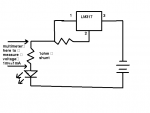brando said:
but I am still getting too many volts- fluctuates between 4.5 and 5.11 without an LED attached... with an LED it reads 2.7v, with an LD 1.8v... running off 4x AA batteries (almost new)
This is exactly the same question that was posted a page or two ago..
The circuit regulates the current by giving the load just enough voltage, for this current to flow through it.
The circuit CAN NOT regulate the current without something for the current to flow through. This is why it gives out the maximum voltage it can (without load) and you get a reading that seems too high..
When something is attached to the output of the circuit, it will automatically adjust the voltage, to achieve the desired current. This current will then stay constant, but the voltage will drop slightly, when the LD gets hot and drops in resistance.
BTW: Powering the circuit up without a load will charge the capacitor to the voltage you mentioned (around 5V). If you then connect the LD to the circuit, the capacitor might still have enough charge in itself, to damage or kill the LD. This is why it is recommended to short the capacitor, before soldering the LD to it.. After that it is best never to remove it again.
Luckily capacitors self discharge quite fast, but it's better to be safe. Powering the circuit up without a load serves no purpose whatsoever.
EDIT: Oh, and not to forget, LEDs have a different forward voltage then LDs. If you simulate the load with a few LEDs in parallel, you will be able to verify if the current regulation works, but the voltages will be different then on the LD at the same current. Since it regulates current by adjusting the voltage, this is what's supposed to happen, and it means it works.




